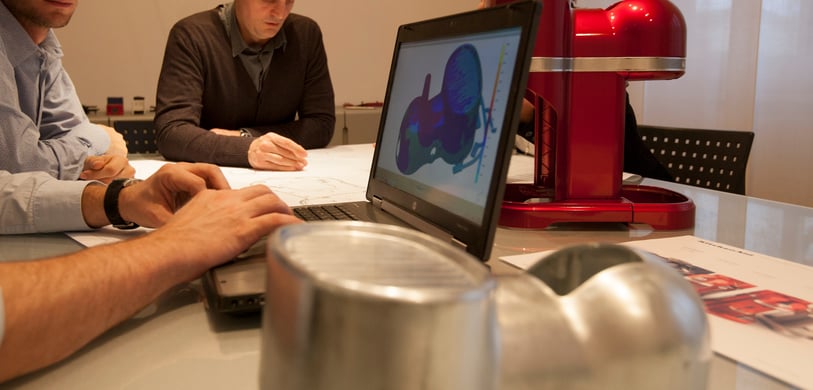As winner of numerous international awards, Bruschi Spa is known for its innovative approach in design and technology. We are glad to share our insights and experiences with the industry members.
Diecast finishes for casting process
Diecast finishes are every industrial processes applied to modify product or component surface in order to improve its aesthetic or technical quality. These processes are applied to improve or modify electrical conductivity, remove burrs and other flaws and for many other reasons. Furthermore, diecast finishes allow obtaining the desired aesthetic feature and coating durability.

Normally, diecast finishes are indicated by clients, but die casting supplier should be able to suggest the most suitable finishing to its clients. In co-design terms customer and supplier should work together in order to obtain a product or component with the same functional and aesthetical characteristics, but less product costs. This is possible thanks to client trust for its supplier and due to supplier’s expertise in different fields.
Diecast finishes are divided into two different categories:
- Processing techniques
- Finishes
Characteristics of diecast finishes
Processing techniques
Processing technique is a mechanical process aimed at changing only product surface, without changing thickness of it. Normally it is done when products do not require a galvanic, aesthetic or protective treatment. In this case, in fact, there is no layer on product surface and the thickness of it is the same as the beginning.
The most important processing techniques in diecast finishes are:
- Vibration
- Sandblasting
- Polishing
Vibration
Vibration is applied through specific machines, where casted products with water and vibrating material are included. This material can be thermoplastic or ceramic inserts with different size and shapes.
During the process components move circularly within vibrating machine: they rub their surface with water and inserts in order to polish it, smooth out sharp edges and eliminate overflows.
This step can be done to clean components after secondary operations.
Sandblasting
Sandblasting has a similar effect to vibration but can be done with two different procedures:
- Static sandblasting: components, with an unconventional morphology or large size, are stuck on a conveyor belt in constant moving. Components are hit by steel spheres with a diameter of 0.3-0.4 mm in order to eliminate the most considerable overflows, in particular near holes or perimetral zones.
- Dynamic sandblasting: is normally used for small components. Components are inserted within a cabin where a rotating rug allows components to be in constant movement. In this case the product is hit by steel spheres or zinc cylinders with a diameter of 0.6 mm. Zinc spheres have less specific weight compared to steel and for this reason can be more useful: because they do not damage product surfaces.
Polishing
Polishing is a process made with horizontal or circular machines fill in with steel spheres with a diameter of 3-4-5 mm. When the machine is moving, component is hit by spheres to sparkle it. This can be totally considered an aesthetic treatment.
Finishes
If the product does not require galvanic, aesthetic or protective treatments finishing is not necessary and the product can be considered finished with uncoated state. If finishing is required hereunder are explained the different types.
Die casting finishes are often given by clients but, a die casting supplier, should be able to suggest its clients the best finishing or recommend an uncoated state for components or products, in order to obtain a finished product with the same functional and aesthetical characteristics but reducing product costs.
In order to accomplish finishes, after processing techniques phase, a mechanical processing technique to prepare component surface is needed.
Diecast finishes are used in order to give protection for oxidation of other external agents. Finishes can be either galvanic treatments or painting.
Every galvanic treatment can be done either static or dynamic.
There are many finishes but the most common are:
- Electrolytic galvanizing: Layer is made of zinc-zamak. It is used to colour the product (white, black or yellow) and allows a galvanic deposit needed to increase atmospheric agents resistance such as salt fog. The aim of this process depends on material choice: in fact can have aesthetic or functional aims.
- Nickel-plating: Layer is made of copper-nickel
- Chromium plating: Layer is made of copper-nickel-chromium. It has an aesthetic function and a good resistance to wears
- Tin plating: Layer is made of copper-nickel-tin
- Bronzing: Layer is made of copper-nickel-bronze
To learn more about die casting finishes download our free white paper here
Why use zinc for these treatments?
Zinc has an optimal malleability in mechanical terms, has a lower specific weight compared to steel and a good resistance to corrosion in particular adding finishes.
Zinc allows many different surface treatments and improves the aesthetic and chemical characteristics of a product or component. With zinc is possible to choose the type of preparation process related to finishing: this has to be done in strict collaboration with suppliers who can suggest how to proceed.
If compared to many other materials zinc is stronger, more durable and allows more diecast finishes. This is an important advantage in functional and aesthetical terms: from design to finishing phase.
Normally are clients who decide the type of finishing. For example if clients request a higher resistance, suppliers should consider a sealing galvanization to obtain a resistance of 140-160 h, 33% more than the one allowed by white finishing.
All these aspects lead to decrease costs and increase saving, for this reason the client should be more satisfied.
Please feel free to fill in the form to know more information about this topic and to be always updated on trends and innovations in Zinc Die Casting Industry, you are welcome to subscribe to our blog.

